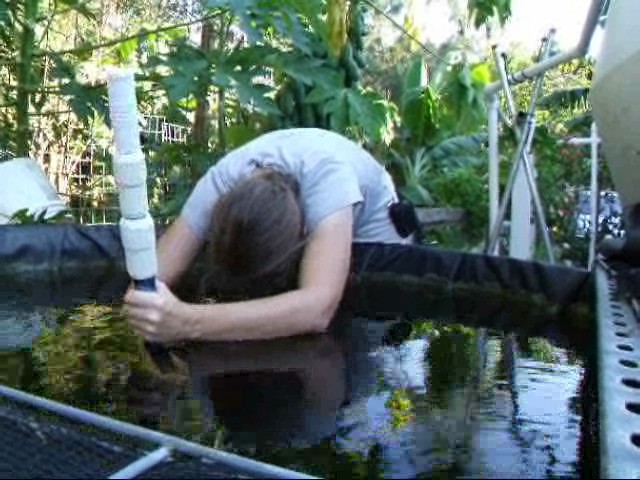Want to sequence the flow of water into your grow beds to only flood one at a time? Want to avoid extra wiring and control electronics? Then consider an aquaponics indexing valve. All that is needed to operate this valve is a flow of water that starts and stops. If you are already running with a pump on a timer, then each time the pump stops then starts again, the water will be sequencing to a different outlet. This is a way to add more grow beds without needing to expand fish tank or sump tank space.

Aquaponics Indexing valves!!!!!!
http://www.aquaponiclynx.com/aquaponicsHIW.swf
The valves come in three different sizes. 1″, 1 1/4″, 1 1/2″ They also come in a few different bodies. 4 outlets, 6 outlets, 8 outlets (only in 1″ though)
There are cams that can be installed in the valves to allow them to operate different numbers of outlets.
For example the 4 outlet body can be cammed to run 2, 3 or 4 outlets and one would simply cap off the unused outlets if any.
http://www.aquaponiclynx.com/aquaponicsBeds.swf
Now these valves are similar to irrigation indexing valves but with some modifications to make them work with aquaponics, there are also additional options we can provide for the aquaponics indexing valves that one can’t get by purchasing the indexing valves at the big box stores.
There are minimum flow and pressure requirements to operate the different models of valves and I can assist in choosing the correct valve for a situation or recommending an appropriate pump size. Here is a link to a site with listings of dealers for different parts of the world.
http://www.aquaponics.vacau.com/
Or if you are along the I-75 corridor between Florida and Michigan, contact me.
Indexing Valves
I currently use two Aquaponics indexing valves on my big system and I am using one Aquaponics Indexing valve on my 300 gallon system.





[…] recommend 600 gallons of flood and drain gravel beds but that will either require a sump tank or an Aquaponics indexing valve. Currently I have a 300 gallon tank hooked up with 3, 100 gallon stock tanks as grow beds. That […]
Hi:
I’m new to aquaponics and don’t want to deal with siphons. Do you know of a valve (initially for a 2′ x 4′ grow bed) which opens and closes (electrical or otherwise) that I could use to control the drain and water level of the bed…where the valve closes at a certain minimum water level…and then opens when the water is at a certain height, permitting it to drain?
Thank you
I would recommend that instead of automating the drain on the bed, you should automate the flow into the bed. Too much danger that if the valve or timer or sensor malfunctioned that the bed would then overflow. I use the Indexing valves to flood just one bed at a time in a Timed flood and drain fashion. The beds have stand pipes with holes near the bottom. The top of the stand pipe is open so when the bed is at the desired max flood height the excess water will flow down the top of the stand pipe till the water flow to the bed stops and then the bed will drain slowly through the holes near the bottom of the stand pipe.
If only using one grow bed, you could simply have the pump on a timer and turn it on for 15 minutes at a time and then leave the pump off for 15, 30 or 45 minutes to let the bed drain.
If you will have more grow beds, then the indexing valve may be appropriate for you if your pump pump is strong enough to operate it.
Need indexing valve recommendation. Setting up an 800 gallon FT and 250 gallon sump. Constant stream from 1800gph pump from sump split half of stream back to FT, which gravity feeds back into sump. The other half of the stream from pump feeds into a 50 gal radial filter which gravity feeds into a 50 gal swirl/bio filter which then gravity feeds into 2 – 4×8 grow beds, which then gravity feeds back into sump using bell siphons. 1-1/2″ pvc piping for radial and swirl filters. My understanding is the 1-1/2″ index valve would work better with the low pressure coming from the swirl filter which will feed two grow beds and eventually 2 future grow beds. Index valve is to minimize the water volume change in the sump as I will use it for fingerlings at one point.
Any advice on valve selection, height of index valve in comparison to swirl filter and grow bed and any other advice is welcomed. Can this be accomplished with just the indexing valve without the use of a timer mechanism?
Thanks for your help.
John
No John, your proposed set up probably won’t work.
I would recommend you put the swirl or radial filters right after the fish tank since sending the solids through the pump first tends to make them not settle. Such filters are far more effective if you don’t blend the solids up first.
The easiest way to make the indexing valves work with a CHOP 2 type system would be to alternate flow between the fish tank and the indexing valve. I do this using a motorized diversion valve and a controller.
The indexing valve MUST have the water stop flowing to it so that the mechanism can get ready to send flow to the next bed. If the water flow to the valve never stops, the valve will never index.
And you need more flow and pressure than I think you can possibly get coming out of a swirl filter or settling tank of any sort. Even the Gravity modified valves need about 3 feet of head pressure to engage them.
I have a 2 FT system 220 & 700 gal. My FT’s overflow into a 300 Gal.sump via a 2″ manifold and the sump tanks drain to a lower level pump which returns water to both FT’s . My 6/ea 4′ x 4′ x 16″ grow beds (Media & Raft) are fed from a pump in the 700 Gal. FT and the water returns to the Sump Manifold.
I wish to use an 8 port indexed valve to feed the grow beds 1 at a time and it appears you have the solution.
I use a 1350 GPH pump with a 23 Ft headlift max.
I would recommend a 1 1/4″ gravity modified 6 zone indexing valve for use with a 1350 gph pump provided the head and distance between the pump and the grow beds is kept minimal.
Keep in mind that running the indexing valve directly from the pump means you have to turn the pump on/off in order for the valve to index to the next bed, this is hard on most pumps and is likely to cause premature pump failure or impeller wear. Many people find that it works at the start but as the impeller breaks or wears the pump is no longer strong enough to engage the indexing valve properly.
I now use motorized automated valves (like used for swimming pool applications) to turn the flow of water on/off to the indexing valves and avoid turning the pumps on/off.
The size pump you mention is on the small side for being able to operate indexing valves at all and the 1″ 8 port valve would probably need more pressure to operate well. The 1 1/4″ valve seems to be the best fit for low pressure pumped applications.
Keep in mind that raft beds normally want a continuous flow of filtered water while the media beds are better suited to flood and drain. I would probably not recommend feeding the raft beds with the indexing valve but from their own continuous running pump.
TCLynx
I am considering 3x 100 gallon fish tanks with 6x 50 gallon grow beds, I was considering a flood and drain based on a 15 minute timer. Would using an indexing valve be something I could implement into my system or would I be better off just setting each FT to pump to both grow beds at the same time (my concern being the FT will get too low) unfortunately I don’t have space for a sump tank.
thanks for your time!
An Indexing valve would only be appropriate if you can use a single pump that would be strong enough to operate it. (Most people with small systems are not willing to use a large enough pump to operate even the “gravity Modified” indexing valves.) The smallest pump I have ever gotten to reliably work with an indexing valve is the Quiet One 4000 (that is a 50 watt pump that at 0 head moves almost 1000 gph) and that install had the tops of the grow beds at only 24″ above the water level in the fish tank.
If you have 300 gallons of grow beds total and 300 gallons of fish tank total, you can do a simple system without a sump tank since this is a 1:1 system. The water level in a 1:1 system may fluctuate as much as 40% once the media fills the grow beds and the fluctuation will usually be less if running a siphon system. Or you could always take the bells off some of the siphons and run some beds constant flood to reduce the water level fluctuation even more. Even if you run timed flood and drain the water level fluctuation is still only going to be about 40% before you get roots into the beds. The main issue is to not over stock your system. With only 100 gallons of media per fish tank, I would probably only recommend 10-13 fish that might grow out to 1 lb each or 30-39 fish total for the 300 gallons of fish tanks.
Biggest issue with having three fish tanks on a single system with a single pump is you need to make sure you plumb the fish tanks together with a large enough pipe to keep up with water flow equalizing between the fish tanks. And yet keep the fish from swimming into those pipes.
If you were always planning to run the three fish tanks separately with three separate pumps, then a single indexing valve is definitely NOT going to work for you.